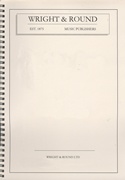We've found 788 matches for your search. Order by
Results
-
 £59.95
£59.95Concerto Grosso (For Bb Cornet, Eb Horn, Trombone, Euphonium and Brass Band)
Estimated dispatch 7-14 working days
-
 £44.95
£44.95Dance Sequence (Trombone Solo with Brass Band - Score and Parts)
Estimated dispatch 7-14 working days
-
 £24.95
£24.95Introduction and Burlesque (Bass Trombone Solo with Brass Band - Score and Parts)
Estimated dispatch 7-14 working days
-
 £24.95
£24.95Rag and Bone (Trombone Solo with Brass Band - Score and Parts)
Estimated dispatch 7-14 working days
-
 £24.95
£24.95Recitative and Romance (Trombone Solo with Brass Band - Score and Parts)
Estimated dispatch 7-14 working days
-
 £24.95
£24.95Sound an Alarm (Trombone Solo with Brass Band - Score and Parts)
Estimated dispatch 7-14 working days
-
 £26.50
£26.50The Acrobat (Trombone Solo with Brass Band)
Please note that there is no score included in this set. A full score is not available for this work
Estimated dispatch 7-14 working days
-
 £129.95
£129.95Trombone Concerto (Brass Band - Score and Parts)
Estimated dispatch 7-14 working days
-
 £24.95
£24.95Trombonioso (Trombone Trio with Brass Band - Score and Parts)
Estimated dispatch 7-14 working days
-
 £50.90
£50.90Basin Street Blues (Trombone Trio with Brass Band - Score and Parts)
Grade: medium.Duration: 3:28
Estimated dispatch 7-14 working days
